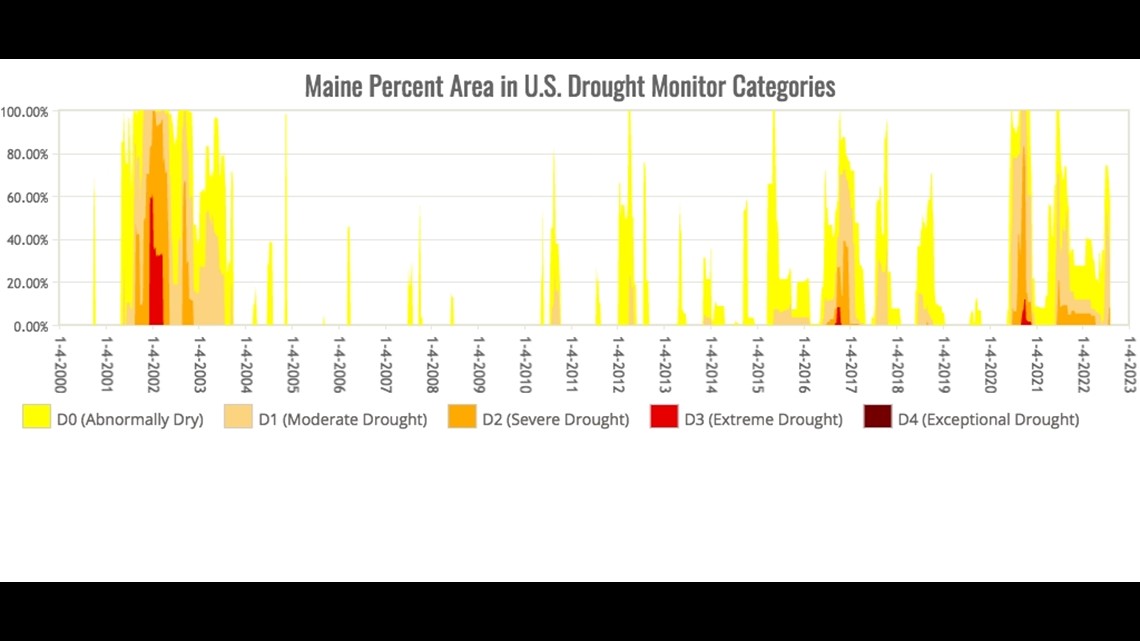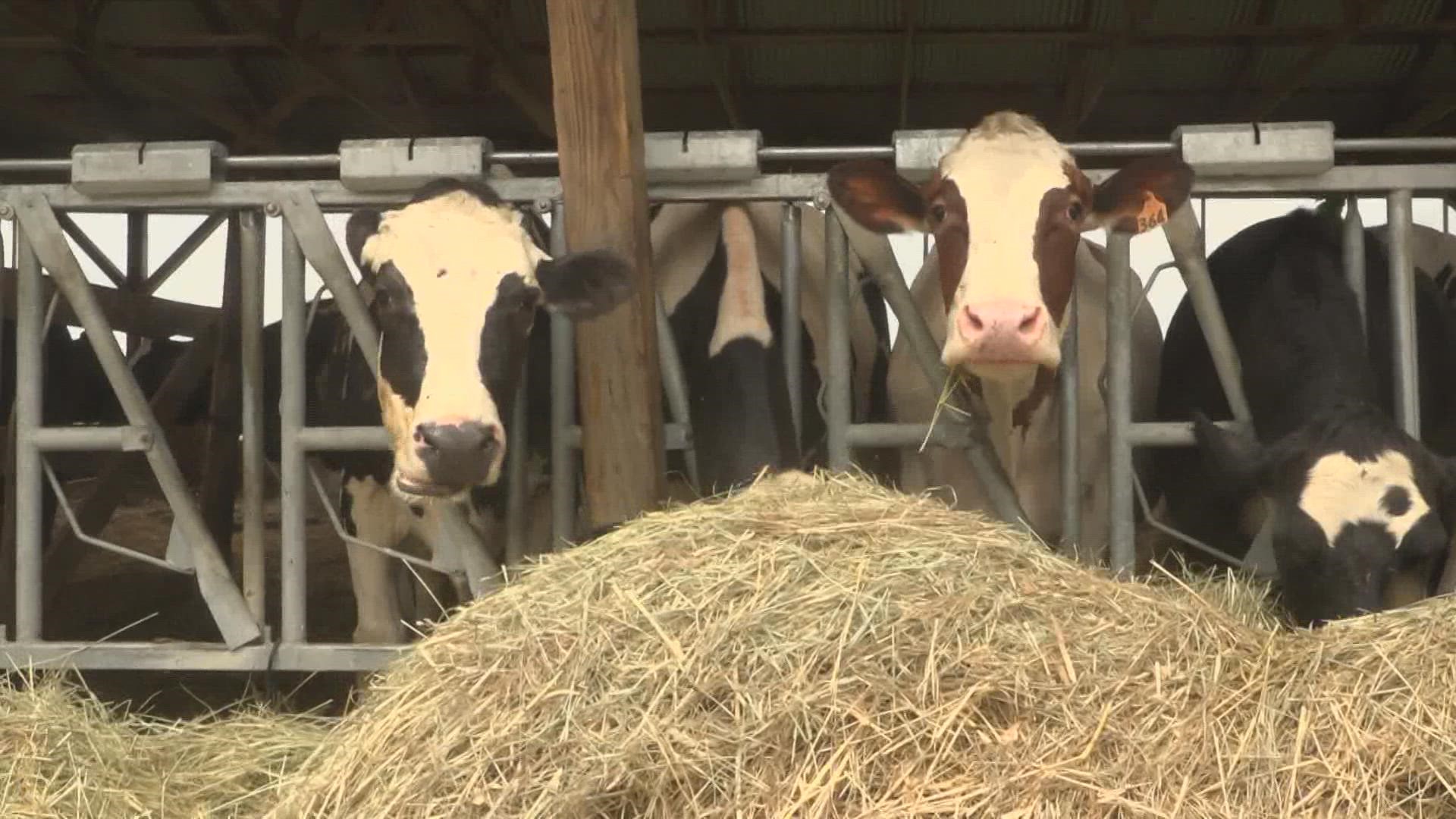DAYTON, MAINE, Maine — The start of August brings changes to a dairy farm. At Harris Farm in Dayton, dairy farmer Jake Harris knows the last full month of summer brings the start of the third harvest of hay for his 40 dairy and beef cows.
Hay harvesting at most of the farms in the northeastern U.S. typically spans three harvests: once in the spring, another in summer, and the final in late summer or early fall. But this year, Harris can’t get his second harvest to grow.
This is because of a significant drought impacting much of Maine’s southern and western counties. In York County, where Harris Farm houses its cows, more than 65 percent of the land is in a severe drought, according to Drought.gov.
Jake normally takes abnormal growing years in stride.
“You never know what you’re going to get from year to year,” Harris said. “You have to be prepared for an excellent crop or be prepared for very little crop.”
Jake is referencing the harvest season of 2021, adding that the summer brought so much rain his corn plants wilted because of oversaturation.
But now, in 2022, the corn plants have started to wilt again because of ongoing drought conditions.
“We've definitely been experiencing more dry summers like this than when I was a kid,” Harris said.
Harris said if they don’t get consistent rain soon, the second harvest could remain stagnant at just a few inches tall, when it should be more around half a foot to a full foot.
“The second cutting of grass is much better quality and a higher source of protein. … They are missing out on it when they’re not on the pasture,” Harris said.
The decline of the second harvest has led to the Harris Farm giving their cows soy supplements, costing the farm a significant amount of money.
"That’s a pretty substantial added cost. That stuff is very expensive,” Harris said. "The animals need to get fed no matter where it comes from."
Harris is determined to fight for his cows and his livelihood.
"I have to grow crops to feed these animals. My animals need to be taken care of no matter what. We've been trying to make ourselves more resilient," Harris said.
But the recent drought conditions could be a sign of things to come in Maine's changing climate.
Two climate professors agree Maine's changing climate has contributed and will continue to contribute to warming temperatures around New England.
Dr. Sean Birkel with University of Maine and a climatologist with the state told NEWS CENTER Maine the average temperature of Maine increased 3 degrees Fahrenheit over the past century.
Dr. Birkel added that while more arid regions of the country will get drier with the increasing temperatures, the northeast will actually get wetter and hotter. The heavier rains combined with increased temperatures could bring intense weather on both ends of the spectrum.
"The climate of the northeast region will get wetter, because of a tendency to more extremes, there is research showing in this warmer climate there may be an increased likelihood of drought or heavy rain," Dr. Birkel said. "As temperatures rise in an increasingly warm season ... there's enhanced evaporations so any drought that does happen, the impacts can be intensified."


Dr. Birkel said periods of drought and heavy rain exist in the northeast without human contributions to climate change, such as a heavy drought period in 2002 followed by a heavy rain period from 2004 to 2014, but both those weather patterns will increase in intensity as temperatures rise.
Dr. Phil Camill with Bowdoin College's environmental studies program agreed that Maine's climate will continue to warm, with projections showing wetter conditions.
Camill said farmers must continue to adapt and find ways to flow with a changing climate.
"It's about looking at ways to adapt to weather conditions that can deviate from weather we normally expect and how do you adapt to years that are much wetter and much dryer with the understanding that either could show up any time," Camill said.
The future of agriculture in Maine is uncertain, but Harris Farm's dairy farmers are looking for ways to adapt.
"We need to change the way we are doing things, the type of crops we are growing, our irrigation infrastructure, overall crop management and the timing of what crops we grow and when and what we harvest and just keep that in mind and be prepared for everything," Harris said.
Harris isn't alone in his efforts. He works with a full-time farmhand who was one of the last graduating classes from Vermont Technical College's now-shuttered dairy program.
Stephanie Tibbetts said she is in the dairy industry for the long haul, despite living in the face of climate change and drought.
"Caring for the animals is so rewarding. Seeing them thrive and then days later have their own calf and seeing them thrive. It's so rewarding," Tibbetts said.
While the drought continues to worry farmers across southern and central Maine, there is government assistance.
The USDA Natural Resources Conservation Service in Maine has applications open until Aug. 26 for technical and financial help for farmers in need.
The funds help with updated infrastructure such as irrigation along with financial aid and would be applied for the 2023 growing season.

